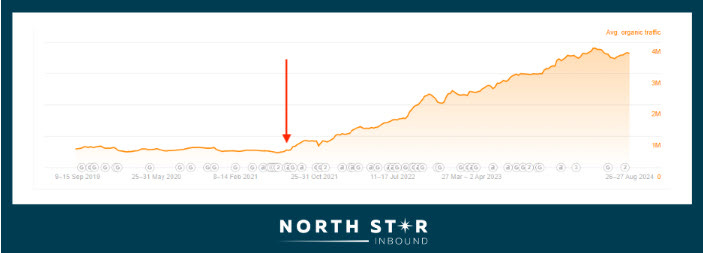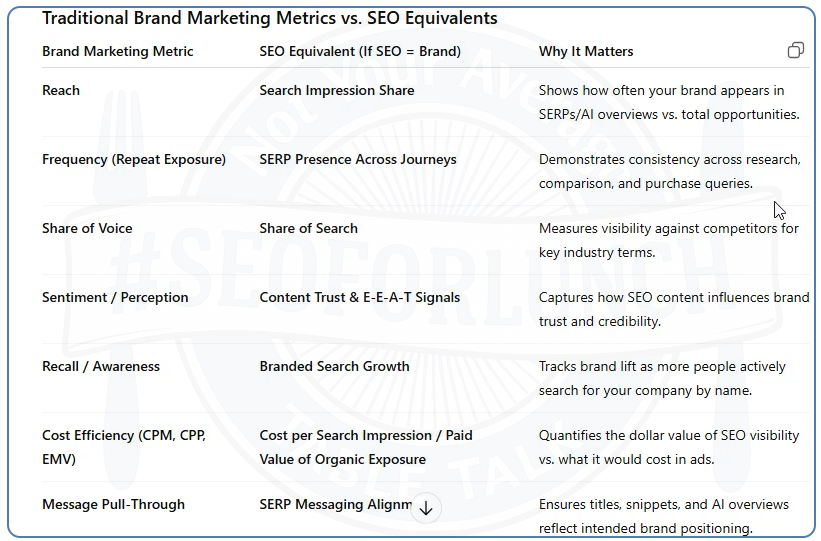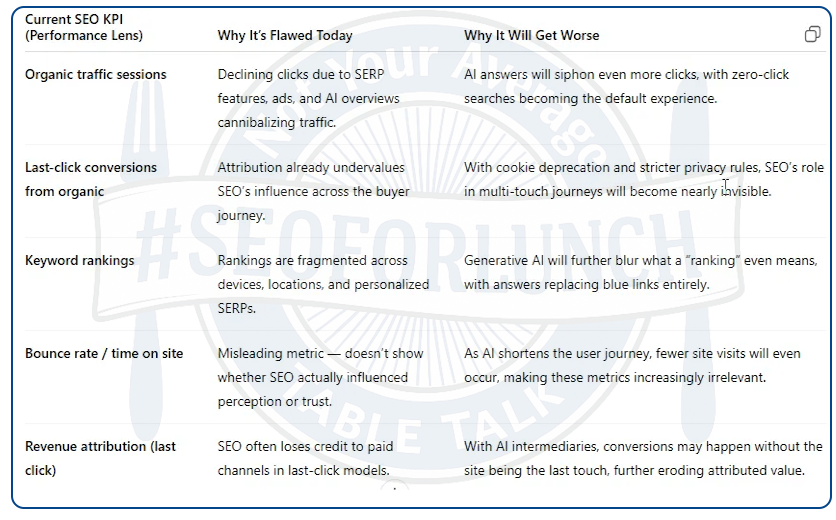What If We’ve Been Measuring SEO Wrong All Along?
Clicks and attributable conversions are collapsing. Maybe it’s time to stop treating SEO like performance marketing, and start treating it like brand marketing.
This week's #SEOForLunch is sponsored by North Star Inbound I know you're thinking I took crazy pills this morning, but hear me out.
Google continues to strip clicks, attribution makes organic traffic appear less valuable than it actually is, and the data becomes increasingly murky every week. If SEO continues to be treated purely as a performance marketing channel, are we setting ourselves up for a world of pain? I think so. But here’s the twist: the very KPIs we roll our eyes at in performance marketing might actually unlock real value…if we reframe SEO as a brand marketing initiative.
Let’s dig into this a bit more.
Thank you to this week’s sponsor: North Star Inbound.
Turn Your Blog Into Your Biggest Sales Engine
Brought to you by North Star Inbound–the sales enablement SEO agency.
How? Focus on high-impact SEO strategies that target the most profitable opportunities.North Star Inbound has a proven track record of creating top-converting blog pages that deliver
thousands of leads,
hundreds of thousands in directly-attributed revenue,
and rapid payback periods on SEO spend.
They focus on the 10% of pages with the highest ROI for your brand. Basically, your content becomes your most effective sales tool.
There’s no better way to loosen tight budgets than to grow revenue quickly.
Intrigued?
The Problem With SEO as Pure Performance Marketing
Most executives still evaluate SEO the way they evaluate paid channels. Even without clean ROAS numbers, that’s the benchmark. Add in SEO’s slower time to establish a positive ROI and the erosion of “progress metrics” like clicks, rankings, and visibility with every Google update (even if they won’t admit it publicly), and it’s no surprise leaders are questioning its value.
Factor in the fact that attribution screws over SEO most, shrinking clicks, cookie deprecation, and AI overviews, and SEO appears to deliver only a sliver of its former impact. This is all despite the same investment in content, links, technical fixes, and navigating SERP volatility.
From a leadership perspective, the easier path is clear: allocate the budget to paid media. Predictable returns, less friction, and none of the complexity that SEO uniquely brings to the table.
But what if we stopped viewing SEO as a form of performance marketing altogether?
How SEO Fits the “Brand Marketing” Mold
I’m not here to say SEO is cheap, but when it works, it’s extremely efficient. The problem, as mentioned previously, is that while it often costs just a single percent of paid media budget, the returns are smaller and the friction is infinitely higher. It even provides a much larger “halo effect” across other marketing efforts that often aren’t attributed back to organic efforts.
So what if we started measuring organic efforts through the lens of brand marketing? Yep, similar to how PR, TV, Radio, Billboards, and, dare I even say, print advertising? All of these efforts are valued by the same business execs but held to a completely different “ROAS” than paid media and SEO.
What typical brand awareness campaigns are judged on
reach
awareness
perception
recall
Do these sound familiar in the context of SEO, perhaps?
Impressions
Visibility
Rankings
Long-term memory (Brand)
All these KPIs are ones SEOs (like myself) scream for the industry to stop reporting on. This is because they don’t support performance-based marketing. They support brand-based marketing.
Rethinking SEO KPIs in a Brand Context
OK, I’ve got your attention—so what does organic visibility look like when treated as part of a brand marketing campaign? Let’s reframe a few familiar SEO KPIs that are often overlooked in a performance-driven model.
Share of Search & Impression Share
I’ll be honest, I’ve never been fond of “share of search.” Unless you can reliably capture all relevant queries in a niche, it feels too susceptible to gaming. But when aligned with business leaders, it can still serve as a directional signal and a valid trendline to demonstrate momentum over time.
Impression share, on the other hand, is a concept brand marketers already understand. Why not use it in SEO? This goes beyond just Google Search Console. Think pageviews in Analytics, impressions in YouTube or social, branded content placements in third-party publications, even mentions within LLMs and niche communities.
These are all places where your brand should appear, but because success is typically measured within silos (search traffic, social reach, PR “eyeballs”), they rarely receive budget or cross-channel focus. A brand-centric SEO approach would reward visibility across the full spectrum, not just traffic that shows up in GA.
Brand Sentiment and Trust Signals
What if organic visibility across search and LLMs helped build positive brand sentiment? SEO has historically helped with reputation management, but is typically asked to work miracles without a business addressing known issues within their brand/product, or service.
“SEO is no longer the cloth that polishes a turd into gold.”
Nick LeRoy (2025)
The best SEOs are already working with their PR teams to optimize these signals. Are LLMs regularly positioning your brand as having X, Y, and Z issues? The team should be working with PR, product, and leadership to address the root issues.
SEO is no longer the art of attempting to polish a turd into gold. That was yesterday’s SEO, and it’s dead.
Indirect impact on conversions through improved awareness.
Yes, conversions and revenue still matter. However, instead of focusing solely on last-click organic data in GA, we should measure SEO’s influence across the entire funnel—what I call organic-assisted conversions.
Examples:
The email team utilizes SEO funded blog content to boost campaign performance → value added.
Paid search improves quality scores and lowers CPCs after SEO-led page optimizations → value added.
The right branded page ranks after a Super Bowl ad, earnings report, or company controversy → value added.
Local listings are accurate, with customer reviews actively managed, further strengthening brand perception → value added.
None of this shows up neatly in Google Analytics. And that’s the problem. SEO is often valued only by first (or last) touch attribution, when its broader influence is far greater. If we measured success differently, the performance narrative would be completely different.
What This Looks Like in Practice
Let’s be real. This shift doesn’t just require a mindset change from SEOs, but from leadership as well. The table below illustrates how SEO can be measured in terms of brand value, rather than being limited to performance-only metrics as we currently view success.
Some KPIs at the bottom serve as a bridge, tying directly to metrics leadership already understands. This makes the transition far smoother than going cold turkey into brand-only reporting.
Think about how PR, TV, and radio are measured: impressions. Now imagine applying that same lens to SEO. If organic visibility across search, social, LLMs, and third-party sites were valued at the same cost as paid impressions, SEO wouldn’t be seen as optional. It would move from a “nice-to-have” to a must-have, because its impact would be quantified in terms that leadership already trusts.
The Risk of Not Investigating Alternative Measurement Solutions
The most obvious risk is that businesses and leadership stop investing in organic strategy and settle for what they can get… well, organically.
The bigger risk of doing nothing is the larger impact on the business's bottom line when organic is held exclusively to yesterday’s SEO KPIs.
Benefits of the Brand Marketing Lens
When marketers first started tying AI Overview or LLM impressions to SEO visibility, I pushed back hard. At SMX Advanced earlier this year, I even joked: “I won’t report on impressions until my energy company accepts them as payment for my utility bill.”
From a performance marketing lens, I still stand by that. But if we shift SEO into a brand marketing context, impressions suddenly carry real weight. They become signals of reach, awareness, and influence, just like PR or TV campaigns are measured.
Adopting this lens creates space for SEO teams to:
Protect budgets from short-term “performance decline” narratives.
Future-proof SEO in an AI-first search world.
Elevate SEO’s role as a strategic driver in cross-channel campaigns.
Align more easily with PR and communications teams, rather than being forced into a paid-performance box.
Rethinking SEO’s Place in the Marketing Mix
If SEO continues to be judged solely by performance KPIs, it will always appear to be underdelivering against what execs are used to seeing. But when we borrow from brand marketing, a different picture emerges.
Instead of chasing instant conversions, SEO reporting could look more like brand lift studies. Think more tracking trendlines, recall, and sentiment.
Visibility wins can be measured in the same way as TV tracks’ ratings or PR tracks earned impressions. And when PR generates coverage, SEO can amplify it, turning awareness into branded search demand.
The big question is this: what if we stopped fighting to prove SEO in performance terms and instead leaned into its brand value?
Viewed this way, SEO isn’t just another acquisition channel. It’s the connective tissue between awareness and conversion.
The strategy that ensures a brand is present, trusted, and remembered in the moments that matter. Do this correctly, and the value is infinite for all companies.





